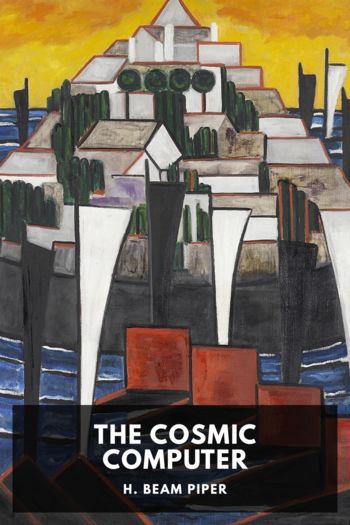Gluck Diana Souhami (smart books to read TXT) 📖

- Author: Diana Souhami
Book online «Gluck Diana Souhami (smart books to read TXT) 📖». Author Diana Souhami
She went on with it all through 1959: ‘work very hard all day against awful disturbances and terrible scenes … paint green swag ribbon.… Do not know what to do to get peace.’12 By October Cyril Salmon was pleading with her to part with it:
Everyone who saw it was in raptures over the portrait and you know already that I think it is perfect. You can’t better perfection – so isn’t it time for the man with the hammer to come and release you from this particular labour? I’m longing to have it …
But she did not let it go.‘… as there is not really such a thing as perfection, she replied (31 October 1959), ‘there is no reason why what passes for it should not be bettered.’
It was not cost effective work – two and a half years for 250 guineas. She became fussed and worried about dichroism, the surface of the canvas and the tuft under the unicorn’s tail. She finally cleaned her palette on 20 May 1960. The next month at a party at the Chantry House, eighty people from the town came to see the portrait. She handed it over to Sir Cyril on 27 June 1960 – three years after the initial commission. ‘A brilliantly original conception brought off miraculously well …’ he called it.13
In August 1960 Gluck went alone for a few days to Seaford. She sat huddled on the beach in a cold wind, reading the four Gospels and planning a painting of the Crucifixion, which never got done. On the way home she bought five black goldfish for the pool and some fish food, and when she got in had a row with Edith about bedrooms, because Helen Beauclerck and a new housekeeper, Miss Burges, were both due to arrive on the same day. In autumn Nesta visited for a day and Gluck felt the strain of trying to cram a year’s news into a few hours. Craig, nearly blind, went into a nursing home and Gluck dealt with the selling of her bungalow and sparse possessions. Edith holidayed in Venice and returned looking well. Miss Burges’s cooking proved unsatisfactory and she left under a cloud. Gluck gave up smoking for two weeks. Anne Yorke invited Gluck and Edith for Christmas lunch at Gatewick. Edith declined the invitation and instead visited Nora. It was the last time the sisters were to spend Christmas together. Three months later Nora died and her ashes were buried in Steyning churchyard beside those of her mother.
Edith became more reserved, withdrawn and compliant, as she reached her octogenarian years. Perhaps she simply felt worn out. Gluck made all the household decisions and bossed her about, but when Edith was alone for a few days she cut back the magnolia that was making her study dark, invited friends to dinner and enjoyed cooking the meal herself.
Gluck painted a portrait of Anne Yorke in 1963. It took three months and she felt frustrated by how slowly the paint dried and by having to work some of the time with a bound right thumb. She severed the tip of it and it was sewn back on by Dr Dunce. The portrait is a tense study, the skin taut, the eyes wide and sad. The sittings inevitably led to outbursts:
Terrible scene with E. late at night which makes me feel terribly ill. She thought she heard me on the telephone. Had listened outside my door. Ghastly. Sad.14
Gluck’s pictures began to reveal a sense of time running out, of compounded loneliness and the coming of death. To herself, she admitted her mistakes, and the waste of her talent:
I have never had a fear of death … when I was young I felt as if I had been thrown out to work my passage home.… I felt death would be the moment of release from the efforts of daily ‘living’… I realised very young the value of lying fallow. I forced rests on myself while painting … then when I felt I had become sufficiently detached, I would return, suddenly. This detachment gave me a less biased eye and I could see whether I had failed or succeeded. But always this longing for a truth I could live and being as I was, this was never to be fulfilled. As life went on I spent it prodigally, unwisely. A sense of timelessness deceived me into thinking my time was limitless for creation. Only within the last tormented years have I seen how ambivalent this sense of timelessness has been. It gave eternal qualities to my work perhaps but it limited its output.
Now I find myself failing in my human strength. I see that I am swimming straight back to He who sent me out and I do want to reach that haven having a prize in my hand. Something worthy of the trust that was reposed in me when I was sent out … I have not done my job yet, so pray to be able to accomplish it.15
She painted a picture of a dead bird and called it ‘Requiem’. Tybalt, the cat, caught and brought in a dead hedge sparrow. This small corpse provided the impetus Gluck needed to work fast. On the third day it started to decompose and on the fifth to smell badly. Gluck stayed up until 2.30 in the morning struggling to finish the painting. By the seventh day she was through and Lovett buried the remains. Gluck cleaned off her palette and the current cook, Mrs Gratcher, served gammon and treacle tart for supper. The picture is of a sorrowful thing – feathers bedraggled, unpreened and incapable





Comments (0)